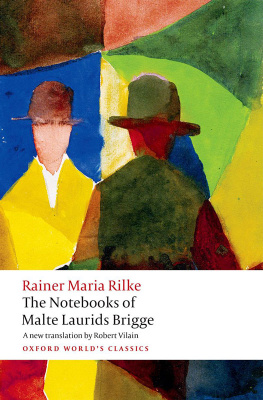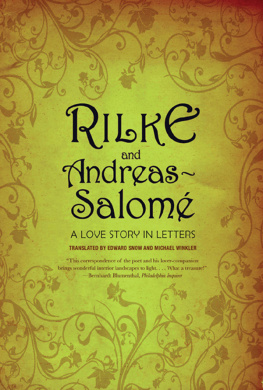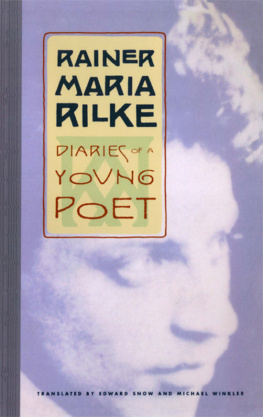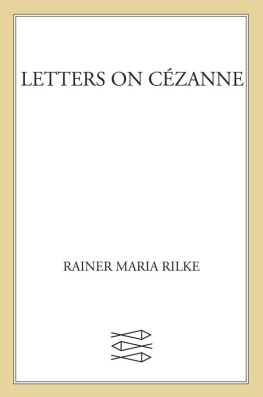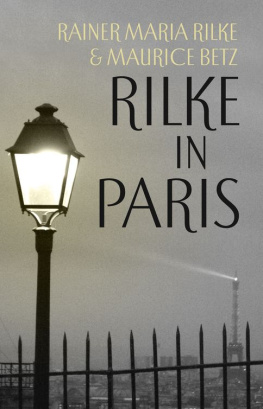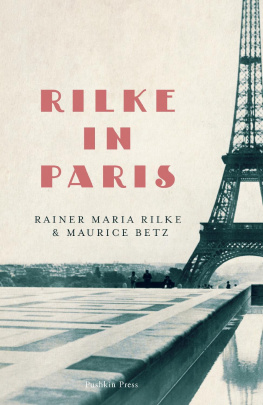Rainer Maria Rilke - The Book of Images
Here you can read online Rainer Maria Rilke - The Book of Images full text of the book (entire story) in english for free. Download pdf and epub, get meaning, cover and reviews about this ebook. publisher: North Point Press, genre: Art. Description of the work, (preface) as well as reviews are available. Best literature library LitArk.com created for fans of good reading and offers a wide selection of genres:
Romance novel
Science fiction
Adventure
Detective
Science
History
Home and family
Prose
Art
Politics
Computer
Non-fiction
Religion
Business
Children
Humor
Choose a favorite category and find really read worthwhile books. Enjoy immersion in the world of imagination, feel the emotions of the characters or learn something new for yourself, make an fascinating discovery.

- Book:The Book of Images
- Author:
- Publisher:North Point Press
- Genre:
- Rating:3 / 5
- Favourites:Add to favourites
- Your mark:
- 60
- 1
- 2
- 3
- 4
- 5
The Book of Images: summary, description and annotation
We offer to read an annotation, description, summary or preface (depends on what the author of the book "The Book of Images" wrote himself). If you haven't found the necessary information about the book — write in the comments, we will try to find it.
Now substantially revised by Edward Snow, whom Denise Levertov once called far and away Rilkes best translator, this bilingual edition of The Book of Images contains a number of the great poets previously untranslated pieces. Also included are several of Rilkes best-loved lyrics, such as Autumn, Childhood, Lament, Evening, and Entrance.
The Book of Images — read online for free the complete book (whole text) full work
Below is the text of the book, divided by pages. System saving the place of the last page read, allows you to conveniently read the book "The Book of Images" online for free, without having to search again every time where you left off. Put a bookmark, and you can go to the page where you finished reading at any time.
Font size:
Interval:
Bookmark:
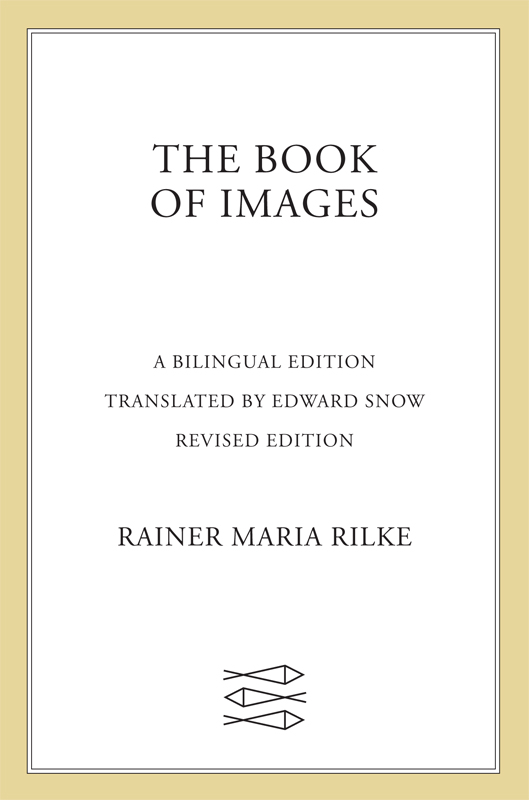
 The author and publisher have provided this e-book to you for your personal use only. You may not make this e-book publicly available in any way. Copyright infringement is against the law. If you believe the copy of this e-book you are reading infringes on the authors copyright, please notify the publisher at: us.macmillanusa.com/piracy. Contents First appeared in the 1906 edition of Das Buch der Bilder. I NTRODUCTION Readers of Rilke in English are probably both more and less familiar with The Book of Images ( Das Buck der Bilder ) than they suppose.
The author and publisher have provided this e-book to you for your personal use only. You may not make this e-book publicly available in any way. Copyright infringement is against the law. If you believe the copy of this e-book you are reading infringes on the authors copyright, please notify the publisher at: us.macmillanusa.com/piracy. Contents First appeared in the 1906 edition of Das Buch der Bilder. I NTRODUCTION Readers of Rilke in English are probably both more and less familiar with The Book of Images ( Das Buck der Bilder ) than they suppose. The volume contains a startling number of Rilkes most famous poems. Autumn, Lament, The Neighbor, Entrance, Evening, Childhood, Autumn Day: these are the poems through which many readers first encounter Rilke, and become mesmerized by his work. They are also the poems that tend to epitomize what it means to characterize somethinga mood, a stance, a cadence, a quality of voice, a way of lookingas Rilkean. Indeed, it could be claimed that if The Book of Images were the only work we had, the Rilke we know would still exist. The poet of memory, of childhood, of leave-taking and looking-back; the poet of night and its vastnesses; the poet of human separations; the poet of thresholds and silences, of landscapes charged with remoteness and expectancy; the poetespeciallyof solitude, in its endless inflections: all are to be found here, in poems as carefully proposed as anything Rilke ever wrote. Yet taken as a whole, The Book of Images probably remains the least familiar of Rilkes major works.
The volume has never been translated in its entirety into English. There are no book-length studies of it. Treatments of Rilkes oeuvre rarely accord it a chapter of its own. Chronologies often misplace it. Many of its most extraordinary poemsThose of the House of Colonna, About Fountains, and Fragments from Lost Days, for instanceremain virtually unmentioned in literature on Rilke. Part of the reason for this neglect must have to do with the volumes scattered, hybrid quality, which makes generalizing about it so difficult.
Indeed, The Book of Images can seem almost studied in its variousness. Callow jugendstil pieces about young maidens and abandoned brides coexist with deftly poised lyrics that seek a complex relation with otherness and the outside world. And all kinds of poems are present. Short lyrics, dialogues, interior monologues, poems in other voices, quasi-ballads, narrative excursions into myth and history, religious poems (serious and wry), psychological portraits, a long requiem, three different poem cycles, and odd stream-of-consciousness pieces (About Fountains, Fragments from Lost Days) fill out the four sections of The Book of Images. Such heterogeneity mirrors the circumstances in which the volume was composed. Most of Rilkes great works came into being rapidly, in short, creative bursts: twenty-six days in 1899 for the first section of The Book of Hours, eight days each in 1901 and 1903 for the last two sections, for a total of one hundred and thirty-five poems; most of the New Poems in successive summers of 1906 and 1907; all fifty-five of the Sonnets to Orpheus and six of the ten Duino Elegies in a single February of 1922.
But The Book of Images evolved gradually, over a seven-year period (June 1899 to August 1906) that spans experiences which mark the great transition in Rilkes early life: his complicated relationship with Lou Andreas-Salom, their two trips to Russia together, and their gradual estrangement; his stay at Worpswede, an artists colony near Bremen where he met Clara Westhoff and Paula Becker, the two friends (one a sculptor, the other a painter) who became objects for him of dreamy, conflicted fin de sicle fantasies (such as those in the poem Girls); his marriage to Clara and his rejection of or by Paula, the two events obscurely related; residence in Paris, where he fell under Rodins spell, became obsessed with a poetry of sculptural thingness, and had his first Baudelairean experiences of inner-city estrangement; the birth of his daughter, Ruth, followed by his gradual distancing of himself from his wife and childa sacrifice to vocation hopelessly entangled with elements of cowardice and bad faith. Amid all this eventfulness, The Book of Images appeared twice, in very different versions. A first edition was published in July 1902 (Rilke was twenty-six at the time), and contained forty-five poems written between 1898 and 1901, the majority of them taken from the diaries Rilke kept at Berlin-Schmargendorfer and Worpswede. A second edition (the one translated here) appeared four years later, in December 1906, greatly altering and expanding the first. In it Rilke mixed in thirty-seven new poems, changed the order of the original sequence, deleted one poem and the final strophe of a second, gave names to untitled pieces, spliced separate poems together (Girls, The Son, Charles the Twelfth of Sweden Rides in the Ukraine), and divided the whole into two books, each with two parts. In the period of revision between the two editions, Rilke was at work on other projects as well, putting old concerns behind him and feeling his way into new ones.
The third and final section of The Book of Hours was written in 1903, and the completed volume was published in 1905. A second edition of the popular Stories of God (first published in 1900) appeared in 1904. The Lay of the Love and Death of Cornet Christopher Rilke, written in 1899 and a favorite whenever Rilke gave readings, was published in its final form in 1906. A monograph on Worpswede, in which concerns with landscape and painting produce intense visual description, appeared in 1903, along with the first edition of Rilkes book on Rodin, so crucial to the aesthetic of the New Poems. The New Poems themselves were begun during this period (some thirty existed by the time Rilke wrote The Voices, the last piece composed for The Book of Images ), and The Notebooks of Malte Laurids Brigge, which would not be published until 1910, had by 1906 become a major preoccupation. It is no wonder, then, that The Book of Images should make such a varied impression.
In a very real sense the volume spans whole phases of Rilkes career, and can be felt to trace their arc: reaching back to the art-nouveau mannerisms of the earliest poems, containing in its interstices the spirituality of The Book of Hours, overlapping the first of the ego-effacing New Poems, and pointing beyond them (in such poems as Human Beings at Night, The Ashanti, Pont du Carrousel, The Neighbor, and especially The Voices) to The Notebooks of Malte Laurids Brigge, with its feelings about the citys estranging power and the unsettling presence there of Gods maimed ones. Yet at the same time The Book of Images seems without any agenda or unifying vision of its own (in this it differs radically from the works that surround it): its four-part structure seems arbitrarily imposed, and only emphasizes the volume as a sort of catchall, where various experiments in style, genre, subject, and voice find a place. Not that this absence of agenda should necessarily be regretted. It makes for perhaps the most genuinely open of Rilkes works. Even the dozen or so awkward poems in The Book of Images Girls, The Singer Sings Before a Child of Princes, and Requiem, for exampleseem revealing of Rilke the man, the young poet, in ways his earlier or later work seldom allows. Often one has the sense of Rilke writing his way into or through a poem, finding a feeling, an image, a situation, and following it wherever it leads him, not refining out what is weakest in the finished work but leaving it impure.
Font size:
Interval:
Bookmark:
Similar books «The Book of Images»
Look at similar books to The Book of Images. We have selected literature similar in name and meaning in the hope of providing readers with more options to find new, interesting, not yet read works.
Discussion, reviews of the book The Book of Images and just readers' own opinions. Leave your comments, write what you think about the work, its meaning or the main characters. Specify what exactly you liked and what you didn't like, and why you think so.

